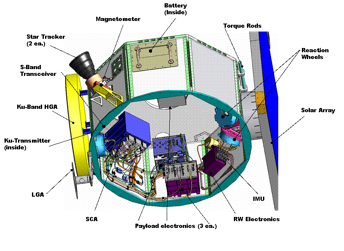 |
| Figure 1 - WISE Spacecraft Components. |
The WISE spacecraft was built by Ball Aerospace, with a design based on the RS300 series of single string spacecraft. The NextSat component of the Orbital Express mission was the first RS300 spacecraft to be launched, and it worked flawlessly. The major components of the spacecraft are shown in Figure 1.
WISE is a three-axis controlled spacecraft that was commanded during the survey to follow long scans at a constant inertial rate. The spacecraft provides attitude control of better than 75", jitter of less than 1.3", and drift rate variation of less than 0.2"/sec over 9 seconds. Angular momentum is stored on board in 4 reaction wheels, and any buildup of excess angular momentum is dumped using magnetic torquer rods. Primary attitude information is provided by two Ball CT-633 star trackers. A fiber optic inertial measurement unit, Sun sensors and magnetometers are used during safe and emergency modes of the spacecraft.
A fixed solar panel provides over 500 watts of power. WISE is oriented so the solar panel is always pointing very nearly at the Sun. During eclipse, a 20 amp-hour lithium-ion battery provides flight system power. Commands are received and flight system telemetry transmitted with two omnidirectional low gain attanna (LGA) working in the S-band, relayed via the Tracking and Data Relay Satellite System (TDRSS). Science data and flight system telemetry are stored on a 96GB flash memory card for later transmission to earth. The spacecraft body steers the fixed high gain antenna to transmit data on the Ku-band to TDRSS for downlink. Science operations have to be stopped during data transmission, so the data downlinks are scheduled while the satellite passes over the poles of the Earth, where the sky coverage is highly redundant.
 |
| Figure 1 - WISE Spacecraft Components. |
Last update: 2011 April 26